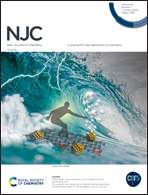S-Scheme heterojunction based on the in situ coated core–shell NiCo2S4@WS2 photocatalyst was constructed for efficient photocatalytic hydrogen evolution
Abstract
In this paper, NiCo2S4 was coated on the surface of WS2 of a 1T/2H mixed phase by a two-step hydrothermal method to form an in situ core–shell structure. The unique S-scheme heterojunction of the NiCo2S4@WS2 core–shell composite photocatalyst improved the easy recombination of carriers caused by the narrow band gap of NiCo2S4 and WS2, and improved the photocatalytic hydrogen production performance. The loading ratio of NiCo2S4@WS2, the addition of Eosin Y, and the pH value of TEOA were optimized. Under the optimal conditions, the hydrogen production rate reached 5.814 mmol g−1 h−1, which is about 8.55 times and 3.35 times the hydrogen evolution rates of NiCo2S4 and WS2, respectively. The composite catalyst exhibits excellent charge separation efficiency in photoelectrochemistry, PL and BET tests, carrier transport rate and large specific surface area that can provide more active sites, which are the main factors for the improvement of the hydrogen evolution performance. This paper demonstrates new design strategies to drive efficient photocatalytic hydrogen production by building in situ core–shell structures and optimizing the carrier transport paths, which will yield new insights.



 Please wait while we load your content...
Please wait while we load your content...